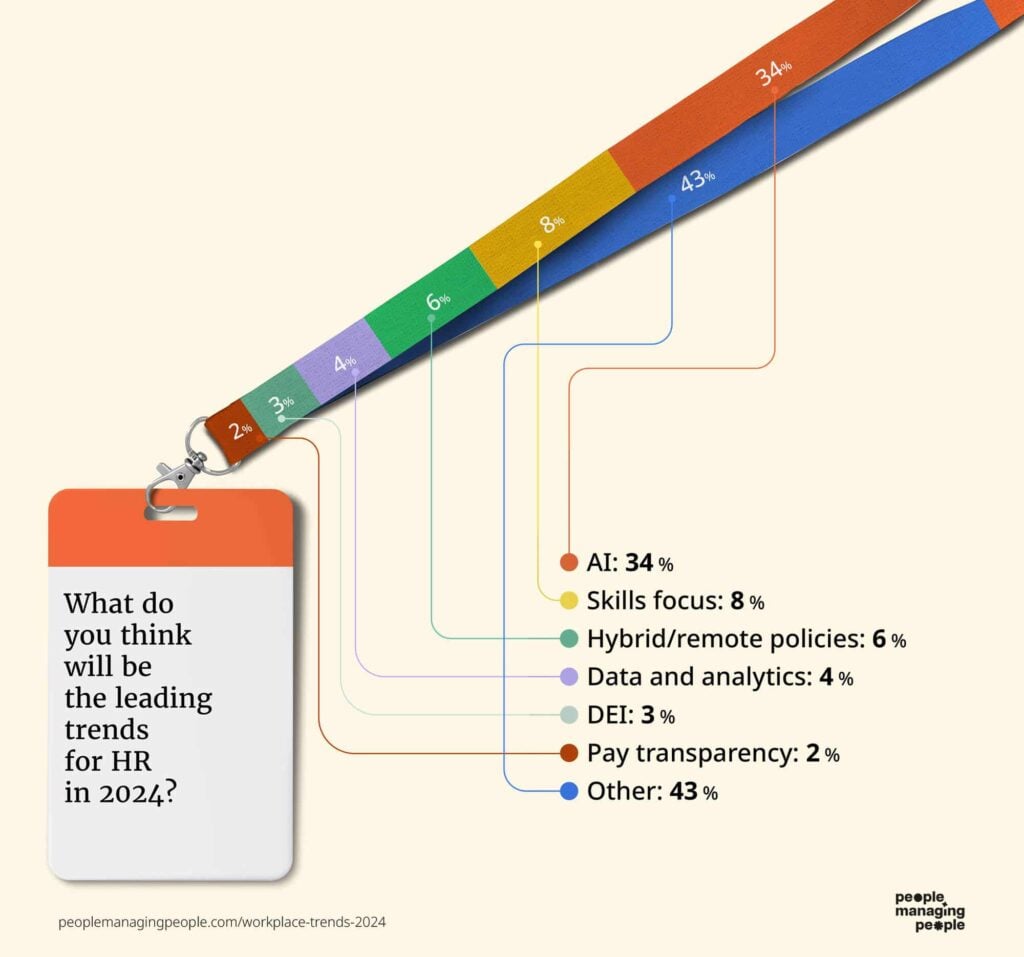"It's funny how day by day nothing changes. But, when you look back, everything is different." - CS Lewis
Our latest HR trends report unearthed some juicy insights into what’s on HR leaders' minds going into 2025 and beyond.

Off the back of our findings and wider research, we’ll cover the 13 top HR trends in 2025.
1. Maximizing the potential of AI and automation
“Everyone needs to have some level of baseline understanding of what AI is, what your policies are associated with it, and how your organization is leveraging it strategically.” - Alex Link, Lead Director, L&D, CVS Health
It’s a common narrative that robots are coming to take our jobs and there is some truth in it.
How it will all play out in the long run is anyone’s guess (we’re hoping for techno-utopia), but it’s thought that currently around 80% of businesses are now explicitly utilizing artificial intelligence in some way.
AI tools such as ChatGPT and other generative AI programs is a HR tech trend that here's to stay. They can be used to create competitive advantage across all business areas, including HR.
It’s down to HR leaders to select the right tools to optimize HR processes such as recruitment, performance management, and analytics, but also to help ensure that the wider organization has the skills present to properly leverage AI technologies for the future of work.
To help, check out our articles on using ChatGPt in human resources, useful ChatGPT prompts for HR, and AI recruiting.
2. Maximizing flexible working
In the furious return-to-office vs remote working debate, it seems most organizations have settled on the hybrid medium.
According to a Gallup report, almost 60% of employees now expect and prefer hybrid work and approximately 40% of remote-capable employees have shifted from working entirely on-site to either a hybrid or exclusively remote work arrangement.
In light of these fundamental changes to how people work, it’s incumbent on leadership and people ops teams to:
- Ensure remote workers and teams have everything they need to work effectively and are treated the same as their in-office equivalents
- Maximize the potential of in-person hours
- Nurture the right remote or hybrid culture.
For help adapting to this new mode of working, check out our article How to Adapt to A Hybrid Model.
3. Moving from jobs to skills
Becoming skills-based is something our readers and community members talk about a lot.
This means a shift to focusing on the skills and abilities of employees rather than their job titles or positions.
In such organizations, the emphasis is on identifying, utilizing, and developing the specific skills necessary to achieve business objectives.
“As far as the next year goes, the companies that will be able to move the fastest, get these skills taxonomies together and more accurately predict what kind of skills that they need, they'll be revolutionizing talent acquisition by focusing on skills rather than titles or previous experiences,” says Felicia Shakiba, Founder of CPO Playbook.
The potential payoffs—greater agility and flexibility, more focused L&D, better hiring and retention—are high, but the challenges—properly defining and assessing skills and changing mindsets—are not insignificant.
One solution is to create internal talent marketplaces that act as a kind of internal LinkedIn to help match workers with projects based on their skills and preferences.
4. Layoffs continue
It seems like not a week goes by without another company announcing significant layoffs.
Layoffs impact HR in multiple ways. Often, HR professionals are the ones being laid off, especially recruiters and those in DEI or L&D roles, and, if this is you, we hope you’re doing OK.
Layoffs are also a challenge from a compliance and employee relations perspective. Those remaining are given the unenviable task of helping a mass of employees leave with as little pain as possible and we recommend working closely with your legal counsel throughout the process.
There’s also the tough task of keeping morale up amongst remaining employees who are upset by their colleagues leaving and concerned they could be next.
As an alternative to layoffs, tech company Zapier set up a secondment program that took advantage of transferable skills to move those who wanted to other parts of the business.
If you’re in the unfortunate position where you have to lay people off then take a read of our article on how to lay off employees properly.
5. The big stay
With all the uncertainty around layoffs, the economy, and automation, it’s understandable that many employees are prioritizing job security.
This is leading to what some commentators are referring to as ‘The Big Stay’ or even ‘The Grump Stay’.
The crux is that a volatile job market means that, in certain instances, talent that would normally move on is choosing to stay put.
“There’s a fear of layoffs impacting people's sense of job security, so I think a lot of people right now are staying in jobs that they don't generally enjoy doing, or at companies that they don't want to work for, simply because there's a fear of it being harder than another job,” said Weronika Niemczyk-Savage, Chief People and Culture Officer at tech startup Cyncly.
6. 4-day workweek picking up steam
In the USA, independent senator, Bernie Sanders, recently proposed a bill to reduce the US working week from 40 hours to 32.
He cites increased worker productivity since the 1940s and the gains from automation and technology as drivers of the reduction.
Numerous trials have shown the potential benefits of a shortened (4-day) workweek including easier recruitment and increased worker health and satisfaction.
But it's not without its difficulties.
Take a read of our article on successfully implementing a 4-day workweek to find out how they achieved it and what the outcomes were.
7. Pay transparency
New pay transparency laws are coming into effect across the United States and Canada mandating that organizations start sharing salary ranges internally with employees and externally on job postings.
This is good news for lower-salaried workers as pay transparency laws in Norway saw their incomes rise 5% as a result—a stat that backs up pay transparency as a driver of pay equity.
Further, displaying salary ranges in job ads has been found to increase the number of applicants by 90%.
In our view, pay transparency is a win-win for businesses and workers, here’s some guidance on how you can approach it.
8. Focus on employee experience design
Increasingly, we’re seeing HR and People and Culture teams take a design-led approach to improving the employee experience.
This means borrowing concepts from UX and CX teams, like employee journey mapping for example, to design products and services that increase employee engagement, product, and retention.
Another key facet of this is staying on top of the latest trends in employee benefits and ensuring that you're offering the type of benefits and perks your employees value.
9. Diversity, equity, and inclusion to the fore
Did you know that by 2065 it’s predicted that there will be no dominant ethnic or racial group in the US?
As populations diversify and become older and Gen Z enters the workforce the issue of diversity, equity, and inclusion will need to be finally tackled properly.
This will take the form of increased budget for DEI projects, the appointment of DEI officers, and initiatives such as employee resource groups, advisory boards, and task forces.
While we’re aware that a lot of DEI folks have been laid off, and that some budgets have been slashed, this only goes to show what some companies really value
This trend is unstoppable.
Pro Tip: Do your own pay equity audit to ensure compensation is fair across your company.
10. Global workforce
With the advent of remote work, we also see another trend: the rise of a globally distributed workforce.
Whereas before hiring a worker from abroad was a bit scary and complicated, as companies become used to remote working, hiring someone from a significantly different time zone will become more normal.
To make the process easier still, global hiring platforms and services are growing in prevalence, taking the burden off HR teams.
11. Onboarding 101
According to a study by Sapling, 88% of organizations still don’t onboard well.
When the pandemic forced everyone to work from home, the already struggling onboarding process suffered. HR professionals found that remote hiring, onboarding, and training were even bigger challenges.
The wins are there to be had—89 percent of those who received effective onboarding reported feeling more engaged at work, according to a BambooHR study.
12. Unionization
In the U.S., approval with labor unions is at the highest level since the 1960s and we’ve seen unions being formed at high-profile companies such as Amazon and Starbucks.
If this trend continues and unions continue to grow in power, more HR professionals will have to play go-between between senior leaders and employees and adapt to work with them.
Expect a lot of employee and industrial relations but, fear not, unions and HR can actually work together and a contrastive union can help both parties get the best deal for them.
13. Toward new operating models
Most HR teams, at least in larger organizations anyway, operate on a form of the Ulrich model: HR business partner, centers of excellence, and shared services centers.
However, some argue that this model is outdated because business partners end up getting burdened with too much admin and some companies are now moving toward more complex work environments, for example temporary, cross-functional teams.
One new model well is EY’s People Value Chain (PVC) model. It consists of three components: people consultants, the digital people team, and virtual global business services (VGBS).
People consultants work closely with senior execs to aid in talent management and development, the digital team implements new technologies to support employees, and virtual global business services take care of administrative tasks and operational services.
EY estimates that combined, VGBS and the digital people team can handle an astonishing 72% of HR’s current scope of work.
This can free up substantial HR resources that can then be redeployed to deliver value in other ways.
The PVC model is one of a number of new models being tested and developed and, while these things normally take time, it’s a trend worth keeping an eye on, as highlighted by HR influencers.
What's Next?
The future is never certain, but we’re pretty confident in what we’re seeing on the above. As you look to create a playbook to deal with the challenges you face, be sure to sign up for the People Managing People newsletter. You'll get all the latest insights and expert tips to help you in your day to day.
For more content like this, check out our roundup of the latest recruitment trends to guide your hiring practices.



